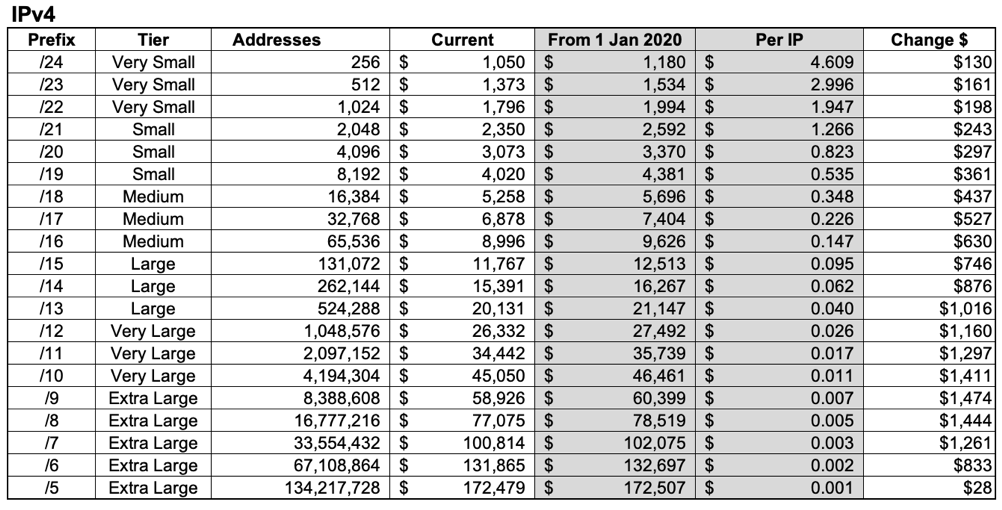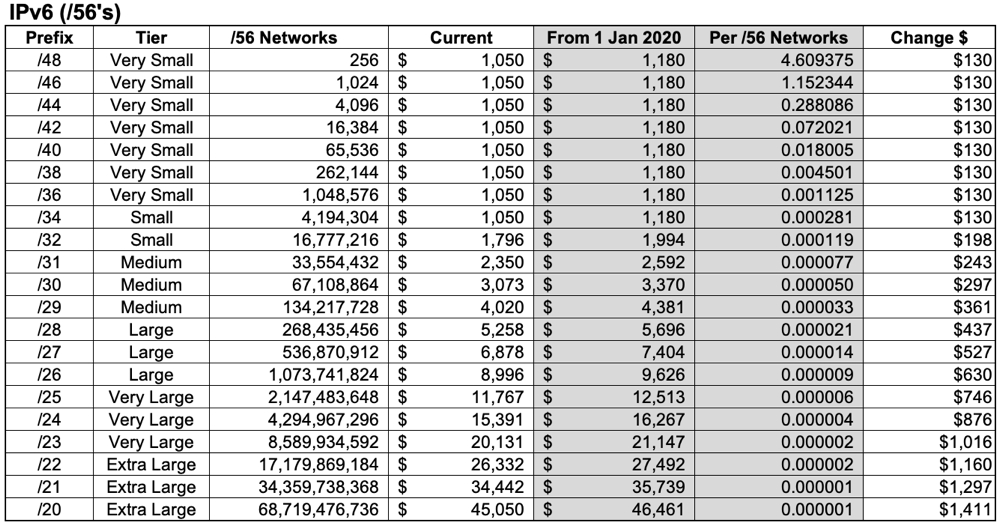
Today APNIC is announcing that the fee schedules for APNIC Member and Non-Member account holders will change from 1 January 2020, with annual fees returning to pre-2015 levels. This will result in an annual fee increase for all account holders, as explained below.
APNIC’s fees were reduced by the APNIC Executive Council (EC) in 2015. At its recent December meeting in Taipei, the EC determined that cost inflation over the past five years required a return to the prior fee structure, to adjust for this inflation.
From 1 January 2020, on renewal of Member and Non-Member accounts, APNIC annual fees will be calculated using the following parameter values:
- The ‘Base Fee’ for Members will return to AUD 1,180 from AUD 1,050.
- The ‘Base Fee’ for Non-Members will return to AUD 1,357 from AUD 1,200.
- The ‘Bit Factor’ for both Members and Non-Members will return to 1.30 from 1.308
Account holders from Least Developed Countries (LDCs) will continue to receive a 50% discount on these published fees. There is no change to other charges in the APNIC fee schedules, or to the ‘premium’ for National Internet Registry (NIR) Members.
For easy reference, the tables below provide the new fees for Members in detail (noting that in many cases, address holdings will not correspond exactly to these values).
The new Fee Schedule for Members and Fee Schedule for Non-Members documents provide more detail. Account Holders can check how much their new renewal fees will be using the Fee Calculator for Members and Non-Members.
A Frequently Asked Questions (FAQ) page is also available, and if you have any additional questions on how this will impact your fees, please contact the APNIC Helpdesk.


The views expressed by the authors of this blog are their own and do not necessarily reflect the views of APNIC. Please note a Code of Conduct applies to this blog.

Anyone under /21 (v4) will be hardest hit if they are not registered in LDC. Last 5yr inflation of Australia is around 8.5% whereas the fee increase for very small operators is going to be more than 10%. I thought we were supposed to support the small operators.
Dear Aftab, thanks for the comment.
The annual fees are restored now to the level which was introduced on 1 Jan 2011, so the better comparison in terms of inflation is 9 years not 5. And I would suggest to take into account service development over this time as well. I hope you would agree that APNIC is providing more and better services than we were 9 years ago, as well.
Thanks.
Paul.
Why you guys are increasing the cost for IP !!??
This is not any product like where you have production cost.
We are little bit concern about which parameters APNIC concern team used to increased membership fees as non-profitable organization on behalf of members.
Based on APNIC last audit financial report 2018, we found that profit after tax is USD1112972 in 2018. which decreased USD 73475 compare to 2017 and asset
USD28820985 in 2018 and asset is USD27708013 in 2017 which means asset is increasing.
These above figure confirm that APNIC still have good amount of profit which value is USD1112972 in 2018 and asset increase gradually for future stability.
So is it necessary to increase the membership fees based on current scenario as a non-profitable organization?
Dear Jahangir
APNIC is a non-profit organisation, and like many other NFPs we maintain a “capital reserve” for future financial security. The reserve is a substantial asset, but it benefits APNIC because it generates a financial return which helps to cover APNIC expenses.
The target size of the capital reserve is equal to 18 months of operating expenses, and this target was reviewed in the last APNIC survey in 2018 (question 36). In the survey response, 35% of survey respondents supported the 18-month reserve, while 24% preferred to increase it to 24 months, and only 13% wished to decrease it.
The current reserve is equal to just 16 months of expenses, but in recent years we have not been able to increase its size, due to a reducing budget surplus. At APNIC 48, the EC Treasurer’s report forecast a surplus in 2019 of AUD 106k, which is around USD 72k.
This is one reason why the EC fee adjustment is needed at this time; without this the reserve would be gradually reduced, against the wishes of Members.
Thanks again for your question, and your support.
Paul.
Dear Paul,
Thanks a lot for your reply with details information.